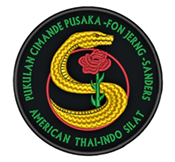 |
Pukulan Cimande Pusaka - Fon JerngYou can email any questions on the style, policies or products to: If you would like someone to call you please include your phone number. |
|||
| Silat Home - Introduction - History - Distance - Silat/Fon Jerng Store - Rank | ||||
Posting on CimandeThe following posting floated around the internet silat lists about a year ago and recently floated around again. By Mr. Ian Wilson Though I am not myself a Cimande practitioner, I did have the opportunity last year to spend some time in Cimande village conducting research for my Ph.D on the historical development of pencak silat in West Java and thought some of my observations may be of interest. According to Bapak Ace Sutisna, the current head of Keluarga Besar Pencak Silat Cimande, the style was developed and spread by Abah Kahir, a native of Cimande, approximately 350-400 years ago. Pak Ace himself is a 11th generation descendant of Abah Kahir from his mothers side of the family. A geneological chart put together by Cimande elders cites 'Embah Buyut', a respectful term in Sundanese language for a great grandfather, as the systems founder. The first generation of practitioners consisted of Embah Rangga and Abah Kahir, followed by Ondong, Kertasinga, Jeprah, Pangiring and Ace Luseha. Cimande spread concentrically throughout West Java,mainly through the agency of Abah Kahir, intergrating with local systems ie. Cikalong in Cianjur, Cikaret in Sukabumi, Serak in Garut etc., to the point that it is often difficult to separate the Cimande elements from those of the local styles. Interestingly, during the several weeks that I spent at Pak Ace's home, many guru silat from throughout Indonesia, including Banten and Jakarta, came to visit him in order to check whether or not the Cimande system that they taught was indeed 'authentic'. According to Pak Ace the movements found in silat Cimande are adaptations of movements common in the everyday routines of rural peasants, ie. ploughng fields, carrying firewood etc. In Cimande tenaga dalam or magical training is not a part of the system, though the sincere performance of religious obligations is considered essential. New students must make an oath (known as a 'talek'), and undergo a ritual intitiation in which their eyes are ritually clensed in order that they may see things as they 'really' are. The style taught in Cimande consists of 3 elements: 'jurus kelid', made up of 33 jurus that prioritise evasive and counter-attack hand movements, 'jurus pepedangan', consisting of 17 jurus using a wooden long sword, and 'jurus tepak selancar',the 'seni' jurus. These jurus are highly aestheticised in order to hide their martial applications to the uninitiated. Despite the development of numerous 'innovations' in silat practice, pencak silat in Cimande is still performed as it always has. The first 12 jurus kelid are practiced in pairs seated in a cross-legged position, a tradition that evolved from the practice of holding training sessions after Quranic recitals.The main object of these jurus is to develop strength in the forearms. After training the forearms are rubbed with an oil made primarily from young coconuts. It is believed that after frequent use of this oil it literally saturates the bones, making the Cimande practitioner impossible to grab.
|